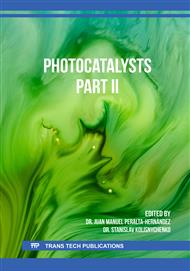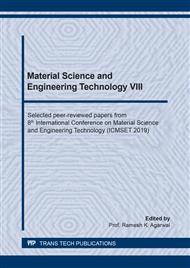[1]
N. Koprivanac, G. Bosanac, Z. Grabaric and S. Papic: Environ. Technol. Vol. 14 (1993), p.385.
Google Scholar
[2]
F. Tardieu: Front. Physiol. Vol. 4. (2013).
Google Scholar
[3]
N. Abdel-Raouf, A.A. Al-Homaida and I.B.M. Ibraheem: Saudi J. Bio. Sci. Vol. 19 (2012), p.257.
Google Scholar
[4]
O. Iorhemen, R. Hamza and J. Tay: Membranes Vol. 6 (2016), p.33.
Google Scholar
[5]
V. Yargeau: Metropolitan Sustainability (2012), p.390.
Google Scholar
[6]
P.A. Pekakis, N.P. Xekoukoulotakis and D. Mantzavinos: Water Res. (2016), p.1276.
Google Scholar
[7]
U.G. Akpan and B.H. Hameed: J. Hazard. Mater. Vol. 170 (2009), p.520.
Google Scholar
[8]
X. Xu and J. Zhu: Recent Patents on Chemical Engineering Vol. 5 (2012), p.134.
Google Scholar
[9]
S.S. Mali, C.A. Betty, P.N. Bhosale and P.S. Patil: Cryst. Eng. Comm. Vol. 13 (2011), p.6349.
Google Scholar
[10]
S.G. Ullattil and P. Periyat: Sol-gel Materials for Energy, Environment and Electronic Applications (2017), p.271.
DOI: 10.1007/978-3-319-50144-4_9
Google Scholar
[11]
M. Arabnezhad, M.S. Afarani and A. Jafari: Int. J. Environ. Sci. Te. Vol. 16 (2017), p.463.
Google Scholar
[12]
P. Nyamukamba, O. Okoh, H. Mungondori, R. Taziwa and S. Zinya: Titanium dioxide – Material for a sustainable environment (2018), p.151.
DOI: 10.5772/intechopen.75425
Google Scholar
[13]
O. Carp, C.L. Huisman and A. Reller: Prog. Solid State Ch. Vol. 32 (2004), p.33.
Google Scholar
[14]
N. Yuangpho, D.T.T. Trinh, D. Channei, W. Khanitchaidecha and A. Nakaruk: J. Aus. Ceram. Soc. Vol. 54 (2018), p.557.
DOI: 10.1007/s41779-018-0184-5
Google Scholar
[15]
T.T.T. Dang, S.T.T. Le, D. Channei, W. Khanitchaidecha and A. Nakaruk: Res. Chem. Intermed. Vol. 42 (2016), p.5961.
DOI: 10.1007/s11164-015-2417-3
Google Scholar
[16]
D. Trinh, D. Channei, W. Khanitchaidecha and A. Nakaruk: Walailak J. Sci. Tech. Vol. 15 (2018), p.787.
DOI: 10.48048/wjst.2018.5969
Google Scholar
[17]
A. Nakaruk, D. Ragazzon and C.C. Sorrell, Thin Solid Films Vol. 518 (2010), p.3735.
DOI: 10.1016/j.tsf.2009.10.109
Google Scholar
[18]
M. Rehan, X. Lai and G.M. Kale: Cryst. Eng. Comm. Vol. 13 (2011), p.3725.
Google Scholar
[19]
D.A.H. Hanaor and C.C. Sorrell: J. Mater. Sci. Vol. 46 (2011), p.855.
Google Scholar
[20]
S.K. Kansal, S. Sood, A. Umar and S.K. Mehta: J. Alloy. Compd. Vol. 581 (2013), p.392.
Google Scholar
[21]
S.T.T. Le, W. Khanitchaidecha and A. Nakaruk: Bull. Mater. Sci. Vol. 39 (2016), p.569.
Google Scholar
[22]
S. Kruanetr, N. Tan-Arsa, and R. Wanchanthuek: Int. J. Sci. Res. Publ. Vol. 3 (2013), p.1.
Google Scholar
[23]
M.N. Chong, B. Jin, C.W.K. Chow and C. Saint: Water Res. Vol. 44 (2010), p.2997.
Google Scholar



